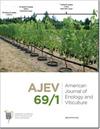Effects of Frozen Materials Other Than Grapes on Red Wine Aroma Compounds. Impacts of Harvest Technologies
IF 1.8
3区 农林科学
Q3 BIOTECHNOLOGY & APPLIED MICROBIOLOGY
引用次数: 1
Abstract
An undesirable sensory attribute (“floral taint”) has been detected in red wines in North America, caused by leaves and petioles (materials other than grapes [MOG]) introduced during mechanical harvest after killing frosts. From 2017 to 2019, several harvest strategies were evaluated on Ontario Cabernet franc: hand harvest (HH), conventional machine harvesting (MECH), Braud-New Holland Opti (OPTI), Gregoire GL8, MECH + optical sorting (MECH+OS), and MECH with preharvest leaf removal (MECH+BLR). Concentrations of 41 odor-active compounds were quantified by gas chromatography-mass spectrometry. Harvest treatment effects varied by season. In 2017, HH resulted in lowest ethyl isobutyrate (MECH+BLR), ethyl nonoate, cis-linalool oxide (plus MECH and OPTI), trans-linalool oxide (plus MECH+OS), β-citral, and cis- and trans-rose oxide (plus MECH and OPTI). Ethyl hexanoate was lowest in MECH, and MECH+BLR, isoamyl hexanoate was lowest in all treatments except HH, and α-ionone was lowest in MECH and MECH+BLR. In 2018, HH resulted in the lowest β-damascenone, ethyl salicylate (plus OPTI and Gregoire), citronellol (plus Gregoire), cis- and trans-rose oxide (plus Gregoire), and eugenol (plus Gregoire). Isobutyl acetate, isoamyl hexanoate, and nerol were additionally reduced by Gregoire, and isopropylmethoxypyrazine was reduced by all treatments except HH. In 2019, harvest strategy affected 27 of 41 compounds, including 11 esters and 12 terpenes. Treatments leading to lowest concentrations were HH (nine compounds), MECH (eight compounds), MECH+BLR (10 compounds), OPTI (21 compounds), Gregoire (10 compounds), and MECH+OS (22 compounds). Wines from fruit that had undergone a killing frost contained different concentrations of 14 and eight compounds (2018), and 17 and 13 compounds (2019) for Cabernet franc and Cabernet Sauvignon, respectively. Results suggest that specific harvest technologies can reduce MOG and associated increases in aroma compounds, although seasonal differences may occur.葡萄以外的冷冻物质对红酒香气成分的影响。收获技术的影响
在北美的红葡萄酒中发现了一种不受欢迎的感官属性(“花香”),这是由在除霜后的机械收获过程中引入的叶子和叶柄(葡萄以外的材料[MOG])引起的。从2017年到2019年,对安大略省品丽珠的几种采收策略进行了评估:手工采收(HH)、传统机器采收(MECH)、博朗-新荷兰Opti (Opti)、Gregoire GL8、MECH+光学分拣(MECH+OS)和MECH+采收前叶片去除(MECH+BLR)。采用气相色谱-质谱联用技术对41种气味活性化合物的浓度进行了定量分析。收获处理的效果因季节而异。2017年,HH导致最低的异丁酸乙酯(MECH+BLR)、壬酸乙酯、顺式芳樟醇氧化物(加MECH和OPTI)、反式芳樟醇氧化物(加MECH+OS)、β-柠檬醛、顺式和反式玫瑰氧化物(加MECH和OPTI)。除HH外,所有处理中MECH、MECH+BLR中己酸乙酯含量最低,MECH+BLR中己酸异戊酯含量最低,α-离子酮含量最低。2018年,HH导致β-大马士革酮、水杨酸乙酯(加上OPTI和Gregoire)、香茅醇(加上Gregoire)、顺式和反式玫瑰氧化物(加上Gregoire)和丁香酚(加上Gregoire)的含量最低。Gregoire还能还原乙酸异丁酯、己酸异戊酯和橙醇,除HH外,其他处理均能还原异丙基甲氧基吡嗪。2019年,收获策略影响了41种化合物中的27种,包括11种酯类和12种萜类。浓度最低的处理为HH(9种)、MECH(8种)、MECH+BLR(10种)、OPTI(21种)、Gregoire(10种)和MECH+OS(22种)。经过杀霜处理的水果制成的葡萄酒中,品丽珠和赤霞珠分别含有14种和8种化合物(2018年)和17种和13种化合物(2019年)的不同浓度。结果表明,特定的收获技术可以减少MOG和相关的香气化合物的增加,尽管可能会出现季节性差异。
本文章由计算机程序翻译,如有差异,请以英文原文为准。
求助全文
约1分钟内获得全文
求助全文
来源期刊

American Journal of Enology and Viticulture
农林科学-生物工程与应用微生物
CiteScore
3.80
自引率
10.50%
发文量
27
审稿时长
12-24 weeks
期刊介绍:
The American Journal of Enology and Viticulture (AJEV), published quarterly, is an official journal of the American Society for Enology and Viticulture (ASEV) and is the premier journal in the English language dedicated to scientific research on winemaking and grapegrowing. AJEV publishes full-length research papers, literature reviews, research notes, and technical briefs on various aspects of enology and viticulture, including wine chemistry, sensory science, process engineering, wine quality assessments, microbiology, methods development, plant pathogenesis, diseases and pests of grape, rootstock and clonal evaluation, effect of field practices, and grape genetics and breeding. All papers are peer reviewed, and authorship of papers is not limited to members of ASEV. The science editor, along with the viticulture, enology, and associate editors, are drawn from academic and research institutions worldwide and guide the content of the Journal.
 求助内容:
求助内容: 应助结果提醒方式:
应助结果提醒方式:


